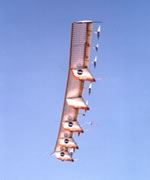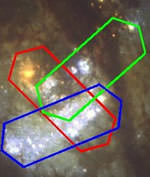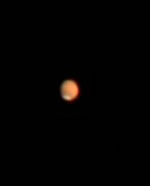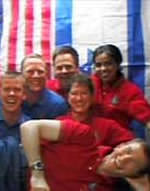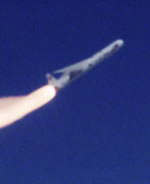
Image credit: Orbital Sciences
Orbital Sciences Pegasus rocket carried an Orbview-3 satellite into orbit Thursday. The Pegasus is different from most rockets because it’s carried underneath the wing of an aircraft and then launched from the air. The Pegasus detached from its L-1011 carrier aircraft and then placed the Orbview-3 high-resolution imaging satellite into a parking orbit 10 minutes later.
Orbital Sciences Corporation (NYSE: ORB) announced that earlier today, it successfully launched the company-built OrbView-3 high-resolution imaging satellite into its targeted orbit aboard the company’s Pegasus? rocket. The OrbView-3 satellite was accurately delivered into an initial “parking” orbit and, over the next several weeks, Orbital engineers will command the satellite to use its onboard propulsion system to reach its final circular operational orbit of 470 kilometers above the Earth, inclined at 97 degrees to the equator. Orbital designed, developed, built and tested the 304-kilogram OrbView-3 satellite for Orbital Imaging Corporation (ORBIMAGE) at the company’s Dulles, Virginia satellite manufacturing facility.
The powered flight sequence for the OrbView-3 mission took about 10 minutes, from the time the Pegasus rocket was released from its L-1011 carrier aircraft at approximately 2:55 p.m. (EDT) to the time that the satellite was deployed into orbit. Preliminary information indicates that the OrbView-3 satellite is working as planned in the early stages of its mission.
“We are very pleased with the results of the Pegasus launch and with the early indications that the OrbView-3 satellite is operating as expected,” said Mr. David W. Thompson, Orbital’s Chairman and Chief Executive Officer. “We look forward to delivering a highly-capable satellite that will allow ORBIMAGE to provide its customers with world-class imagery products.”
Orbital develops and manufactures small space systems for commercial, civil government and military customers. The company’s primary products are spacecraft and launch vehicles, including low-orbit, geostationary and planetary satellites for communications, remote sensing and scientific missions; ground- and air-launched rockets that deliver satellites into orbit; and missile defense boosters that are used as interceptor and target vehicles. Orbital also offers space-related technical services to government agencies and develops and builds satellite-based transportation management systems for public transit agencies and private vehicle fleet operators.
Original Source: Orbital News Release

